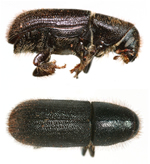
Redhaired pine bark beetle.
Like a celebrity with homes in New York and Los Angeles, the redhaired pine bark beetle is a cosmopolitan pest. The pest, however, has few fans because it may carry blackstain root disease or other pathogens that can be devastating to pines in our urban parks, golf courses and landscapes.
First discovered in New York in November 2000, the redhaired bark beetle surfaced in July 2003 in two locations in Los Angeles County near heavily urbanized areas where exotic pines are favored landscape trees. California and New York currently have the only known established populations of the pest in North America.
Entomologists Mary Louise Flint, University of California Statewide Integrated Pest Management Program, and Steve Seybold, USDA Forest Service, and postdoctoral scientists Deguang Liu and Jana Lee have found some answers about the beetle’s biology, host range and potential impact in California.
The redhaired pine bark beetle is occasionally intercepted at U.S. ports in solid wood packing materials from Europe, and that may be the way it arrived in California. As of December 2006, the bark beetle has been collected by hand or in attractant-baited survey traps in six counties in southern California — Los Angeles, Orange, Riverside, San Bernardino, San Diego and Ventura. The beetle has also made appearances in Castaic on the southern base of the Tehachapi Mountain Range.
The globetrotter is native to southern and central Europe, Russia, the Mediterranean region and the Atlantic Ocean islands. It has also been introduced and has established populations in Australia, Japan, New Zealand, South Africa, South America and Sri Lanka.
Redhaired bark beetles have a broad host range among pine trees and have been reported to kill healthy trees and seedlings in areas outside the United States. The pest can tolerate a wide range of climates throughout the world, so it could survive in other regions of the West outside of California.
The beetle gets its name from the reddish hairs on its wings. The pest feeds on pine stems, large roots or woody debris on the soil surface, and is often found in cut logs of Aleppo pine and Canary Island pine, as well as in green waste piles.
The pest usually breeds in thick bark near the base of the stem or in large exposed roots. Females lay up to 500 eggs and adults are active most of the year, completing at least two generations a year in southern California. Redhaired bark beetles are good fliers, and the scientists observed peak flight activity in May, July and November. Seasonal flight activity varies, though, depending on location.
“Maintaining healthy trees is the key to preventing attacks,” says Flint. “Traditional insecticides for bark beetles are difficult to apply below the soil line and negatively impact the environment.”
The team is searching for behavioral chemicals specific to the redhaired bark beetle that will provide environmentally sound options for managing this new pest. They have already identified an attractant combining ethanol and a-pinene (an ingredient of pine resin) that can be used for early detection. Work is continuing to discover inhibitory semiochemicals that can be used to protect trees from attack and avoid the need for more toxic insecticides.
For now, Flint says infested trees should be removed and destroyed. Pine debris should be chipped or burned in infested areas, and pine firewood should not be moved from infested to non-infested counties. If you find the beetle outside of southern California, report it to your county agricultural commissioner.
The UC Exotic/Invasive Pests and Diseases Research Program and the USDA Forest Service, Pacific Southwest Research Station funded this research program.
_____________________________________________________________
The UC Exotic/Invasive Pests and Diseases Research Program targets research on exotic pests and diseases in California. The program aims not only to improve our knowledge and management of pests that are already here, but also to reduce the potential impact of those pests and diseases that pose a threat to the state. The program is a collaboration between the UC Statewide Integrated Pest Management Program and the UC Riverside Center for Invasive Species Research. U.S. Department of Agriculture, Cooperative State Research Education and Extension Service, funds the program.
Media Contact:
Mary Louise Flint
Entomologist, UC Statewide IPM Program
(530) 752-7692
mlflint@ucdavis.edu
 Redhaired pine bark beetle.Like a celebrity with homes in New York and Los Angeles, the redhaired pine bark beetle is a cosmopolitan pest. The pest, however, has few fans because it may carry blackstain root disease or other pathogens that can be devastating to pines in our urban parks, golf courses and landscapes.
Redhaired pine bark beetle.Like a celebrity with homes in New York and Los Angeles, the redhaired pine bark beetle is a cosmopolitan pest. The pest, however, has few fans because it may carry blackstain root disease or other pathogens that can be devastating to pines in our urban parks, golf courses and landscapes.